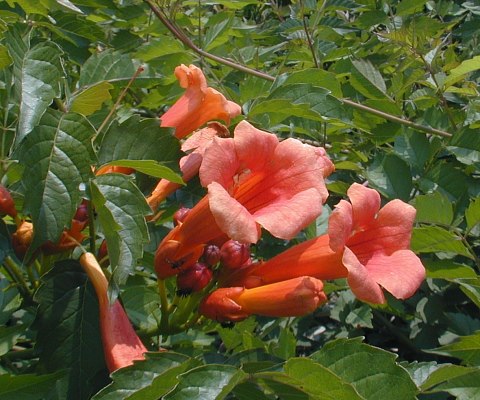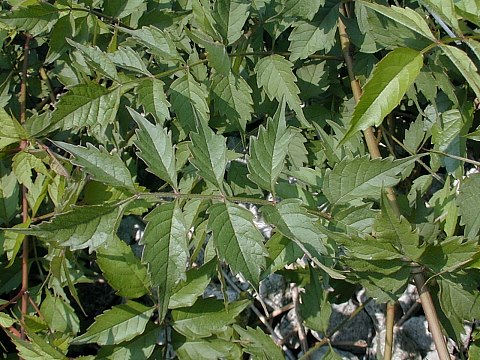Description: This perennial woody vine is up to 40' long, branching occasionally. Trumpet Creeper usually climbs up trees, shrubs, telephone poles, and other vertical structures using aerial rootlets, otherwise it sprawls across the ground. Young shoots are greenish brown, but become brown and woody as they mature. Pairs of opposite compound leaves occur along the length of the vine. These compound leaves are odd pinnate, consisting of about 7-11 leaflets; they are up to 2½' long and ¾' across. The central stalk of each compound leaf is often hairy. The leaflets are up to 3" long and 1" across. They are ovate or elliptic, pinnately veined, and coarsely toothed along the margins. The upper surface of each leaflet is shiny and hairless, while the lower surface often has a few hairs along the major veins.

Periodically,
short cymes of 2-8 flowers are produced along the length of the vine.
These flowers are up to 3½" long and have an elongated funnelform shape
that is trumpet-like in appearance. The corolla is orange to reddish
orange; along its outer rim there are 5 shallow lobes that curl
backward. The tubular calyx is reddish orange, leathery in texture, and
5-toothed; it is much shorter than the corolla. Along the inner surface
of the corolla, there are reddish lines that function as nectar guides
and 4 inserted stamens. There are extra-floral nectaries at the base of
each flower. The blooming period occurs during the summer and lasts
about 2 months. The abundance of flowers is variable; there is no
floral scent. Each flower is replaced by an elongated seed capsule
about 6" long that tapers at both ends. This seed capsule eventually
splits apart into two sections to release the seeds. The seeds are
flattened and have large membranous wings; they are dispersed by the wind. The root system consists of a woody taproot.
wind. The root system consists of a woody taproot.
Cultivation:
Typical growing conditions are partial sun, mesic levels of moisture,
and various kinds of soil, including loam, clay-loam, and rocky. Full
sun is also tolerated. This aggressive vine requires ample space and
vertical support. It has few problems with pests and disease.
Range & Habitat:
Trumpet Creeper is native to the southern half of Illinois and
adventive in the northern half of the state. It is fairly common in the
southern portion of its range, becoming less common or absent in the
north. Habitats include open woodlands, woodland edges, thickets,
savannas, gravelly seeps with woody vegetation, riverbanks, limestone
glades, fence rows, lawn trees, telephone poles, areas along roads and
railroads, and abandoned fields. Sometimes Trumpet Creeper is grown as
an ornamental plant in yards. It tolerates various kinds of disturbance.
Faunal Associations:
The nectar of the flowers attracts the Ruby-Throated Hummingbird,
Baltimore Oriole, Orchard Oriole and some Sphinx moths; the hummingbird
and sphinx moths are effective pollinators, while the orioles have a
tendency to tear-up the flowers, causing more harm than good.
Bumblebees and honeybees sometimes seek nectar or pollen from the
flowers, but they are probably less effective pollinators. The
extra-floral nectaries attract an abundance of ants and flies; to a
lesser extent, Halictid bees visit the extra-floral nectaries as well.
The caterpillars of Paratraea plebeja (Plebeian
Sphinx) feed on the foliage, as do the adults and larvae of the leaf
beetle, Octotoma plicatula. The caterpillars of Clydonopteron
tecomae (Trumpet Creeper Moth) feed on the seedpods and their
contents. The foliage is toxic to mammalian herbivores and little
bothered by them; a small number of people may experience a rash from
contact with the foliage. Because of the luxuriant leaves and rampant
growth of this vine, it provides good cover and nesting habitat for
many species of songbirds.
Photographic Location:
A gravelly area along a railroad in Savoy, Illinois.

Comments: Trumpet Creeper is an exotic-looking vine that looks like something one would expect to find in the tropics. It has large flamboyant flowers and reasonably attractive foliage, but can be very aggressive. There is very little that resembles it, especially in the central and northern areas of the state. In southern Illinois, there occurs the high climbing vine Bignonia capreolata (Cross-Vine), which resembles Trumpet Creeper somewhat and belongs in the same plant family. The Cross-Vine has trumpet-shaped orange flowers like Trumpet Creeper, except that they are a little smaller (about 2" in length). Each compound leaf of Cross-Vine has only a pair of leaflets with smooth margins and a branching tendril. A compound leaf of Trumpet Creeper, on the other hand, has 7-11 leaflets with coarsely serrate margins and no tendril. Trumpet Creeper relies on aerial rootlets to climb adjacent vegetation and objects, rather than tendrils.